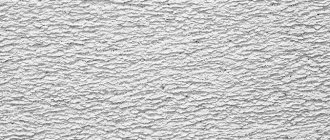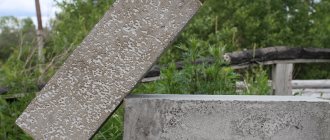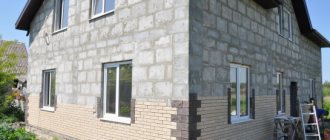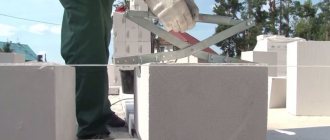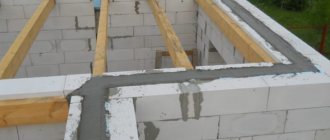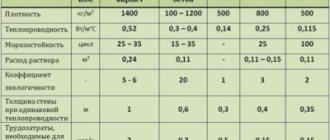The use of aerated concrete blocks in low-rise construction can greatly speed up the pace of construction of walls and partitions. Aerated concrete lintels and blocks are one of the most popular materials used today in the construction of cottages and low-rise buildings. The cost estimate at the stage of constructing the frame of a private house is also reduced significantly. However, in addition to a lot of positive aspects, gas blocks have a number of significant disadvantages. When choosing this building material from aerated concrete, do not forget about its disadvantages. Fortunately, most of them can be easily leveled with due attention.
What is an aerated concrete block?
An aerated concrete block is understood as an artificial stone made of cellular concrete. It should not be confused with foam blocks. In the first material, voids are formed due to the chemical reactions that occur during the hardening of the concrete mass. And in the second, pores are formed by introducing pre-prepared foam into the solution.
It is often confused with gas silicate. In fact, the second gas block is a subtype of the first. The same basic components are used in both cases. Only the proportions and technologies used at the concrete hardening stage are somewhat different. And accordingly, these building materials have slightly different technical characteristics in terms of density, strength and thermal conductivity.
Material structure
Aerated concrete products are made from:
- Cement-sand mixture;
- Quicklime;
- Water;
- Aluminum-based blowing agent.
When lime, aluminum powder and water are mixed, hydrogen is formed. As a result, numerous pores are formed in the hardening concrete. In some brands of aerated concrete, voids occupy up to 80% of the volume. The more there are, the lighter and less durable the building material in question is. However, with an increase in the number of these microcapsules, not only the strength, but also the thermal conductivity of the block decreases.
Factory production of blocks ensures proper quality of material
Hardening of concrete after pouring into molds of the required size is carried out in conventional warehouses (non-autoclave method) or in a special chamber (autoclave method). The use of an autoclave, where a pressure of more than 10 atm and a temperature of up to 200 C is created, allows you to obtain a more durable gas block. This technology is most often used in factories producing this material for building houses.
Expanded clay concrete
Expanded clay concrete is a material obtained by mixing ordinary cement mortar with expanded clay. In addition to the basic components, air-entraining additives (AEA) are used.
The material has been produced since the 60s of the last century. Its production technology is simple, but has a lot of fine details, without which it will not be possible to achieve high quality. For example, the order in which the components are mixed is important (sand is added to cement, mixed, water is added and mixed again, after which expanded clay can be added. At this stage, you need to monitor the thickness of the composition - sometimes expanded clay strongly absorbs water, so you need to add it until you get the desired consistency When the material reaches the required viscosity, it is poured into molds and subjected to vibrocompression.
Advantages of expanded clay concrete:
- high strength (there is no limit on the number of storeys of buildings);
- low water absorption;
- the level of thermal conductivity is approximately halfway between brick and aerated concrete;
- high durability;
- the material is not fire hazardous;
- the cost of blocks is relatively low.
Flaws:
- when constructing tall buildings, it is necessary to reinforce the walls;
- The frost resistance of the material is relatively low;
- There are a lot of homemade expanded clay blocks on the market.
The popularity of expanded clay concrete is quite high - it is one of the most commonly used building materials. Expanded clay concrete blocks for building a house are a popular and effective material that allows you to reduce the cost of construction without losing quality and strength.
Aerated concrete blocks - types and sizes
Standard sizes are regulated by several GOSTs depending on the purpose of the product and concrete hardening technology. However, many manufacturers produce them according to specifications, in which the width, length and height can be specified as desired. It’s good that aerated concrete is cut with a regular hacksaw; it’s not difficult to adjust it to the required dimensions.
According to the Gost standard, the dimensions should fit according to:
- Thickness (width) in the range from 100 to 500 mm;
- Length 600 or 625 mm;
- Height ranges from 200 to 300 mm.
The higher the average density of the material, denoted by the letter “D” in the block brand, the stronger and heavier it is. However, the denser this building material, the fewer voids it contains, which increases its thermal conductivity coefficient.
Based on strength, density and purpose, aerated concrete blocks are divided into three groups:
- Thermal insulation D300–D500 (for insulating walls and erecting thin non-load-bearing structures inside the house).
- Structural and thermal insulation D600–D900 (for interior partitions).
- Structural D1000–D1200 (for load-bearing and external walls).
Table of dimensions and characteristics of wall aerated concrete
| Brand | Length mm | Width mm | Height mm | Density kg/cube m | Frost resistance | Thermal conductivity |
| D-400 | 600 | 250/350/ 375/400 | 200/250 | B1.5/B2/B2.5 | F100 | 0,096 |
| D-500 | 600 | 100/150/ 200/250/ 350/375/ 400 | 200/250 | B1.5/B2/ B2.5/B3 | F100 | 0,12 |
| D-600 | 600 | 100/150/ 200/250/ 350/375/ 400 | 200/250 | B2.5/ B3.5/B5 | F100 | 0,14 |
| D-700 | 600 | 250/300 | 200/250 | B3.5/B5 | F100 | 0,17 |
Regardless of the brand and purpose, the shape of the blocks is usually produced in the form of a rectangular parallelepiped with flat edges. But there are also options on sale with cutouts on the sides to make it easier to grip with your hands, with tongue-and-groove grooves, semicircular and U-shaped for pouring concrete inside.
Various
Heat blocks
Combined type blocks are gaining popularity, for example, heat block, heat wall, polyblock, porotherm.
Manufacturers declare heat blocks and its analogues as an ideal solution not only as the main wall material. Heat blocks are considered universal, made in the form of a multi-layer cake with additional insulation properties.
Heat block Source bizorg.su
In addition, heat blocks can be used as a decorative material for external and internal use.
Pros and cons of aerated concrete blocks
The list of advantages and disadvantages includes:
- High sound insulation rates - with a wall thickness of 300 mm about 60 dB;
- Low density of the material (lightness of the blocks) - in terms of weight, this building material is 5 times lighter than ordinary concrete, and 2-3 times lighter than brick;
- Ease of processing - a gas block can be cut without problems with a hacksaw;
- Low thermal conductivity - with the same thickness, aerated block masonry is 4–5 times superior to brick in this indicator;
- Environmentally friendly and safe - by definition, no particularly harmful substances are used in the production of this artificial stone;
- High speed of construction - the size of a large aerated concrete block is such that it alone replaces 10–15 1NF bricks;
- Absence of cold bridges in aerated concrete masonry;
- Fire resistance and fire safety of cellular concrete.
Aerated concrete blocks are cheaper than other building materials for the construction of walls of low-rise buildings. At the same time, they have good vapor permeability. It is not for nothing that in this parameter they are often compared to wooden log houses. But the brand of aerated block should be selected as carefully as possible.
Wall covering option
For partitions and thermal insulation, you should purchase products that are smaller in thickness and have a large number of voids inside. The option for load-bearing structures should have higher strength and a number in the marking after “D”.
They all have two significant disadvantages:
- High moisture absorption rates;
- Low strength of the material.
The low strength of the material will not affect your home at all if all construction technologies are followed.
Due to the presence of pores, aerated concrete blocks insulate sound and heat well. But these numerous voids make them quite fragile and fragile. You can use aerated blocks to build a house with a maximum of a couple of floors. The lower rows of masonry simply cannot withstand more.
Thanks to the pores, aerated concrete “breathes” and allows steam to pass through. However, because of them, partitions serve as an excellent reservoir for storing water. If waterproofing is poor, the block becomes saturated with moisture, which dramatically increases its thermal conductivity. As a result, all the energy efficiency of the material instantly disappears.
Production technology
Expanded clay concrete blocks are manufactured at many enterprises. As follows from expert reviews, materials from Aleksin, Minskzhelezobeton, Vinziley, Tuymazy, Shakhovskaya, Shaksha are popular. Expanded clay concrete blocks of German quality are especially valued.
The technological process for manufacturing the material at each enterprise is different. Various proportions of raw materials are used; some manufacturers use plasticizer additives that affect the final cost. Because of this, the mixture gains better mobility, fills forms better, leaving almost no empty spaces. Experienced specialists add liquid soap or adhesive instead of plasticizers, increasing plasticity and reducing the amount of water.
The production process can be divided into three main stages:
- An initial mixture is prepared, consisting of expanded clay sand, clean water, cement material and fillers. Cement in this case is a universal binder. The proportions may differ - the strength indicator increases depending on the amount of cement, but at the same time the weight of the block changes and its heat resistance decreases. To make 100 kg of mortar, you will need 54.5 kg of expanded clay stone, 27.2 kg of washed sand, 9.21 kg of cement material, 9.09 kg of clean water. Initially, to prepare a standard mixture, water is poured into a concrete mixer, expanded clay, cement are added, and then sand is added. Everything is mixed for two minutes. To make one block, the size of which is 400 x 200 x 200 mm, you will need at least 11 - 12 kg of solution. It turns out that from the prepared batch you will get 9 - 10 stones.
- It's time for molding. It is performed on vibrating machines; plates made of stainless steel material are inserted into special recesses of the required shape, onto which a mixture of expanded clay concrete is poured. After this, distribution and compaction begin due to vibration, excess raw materials are removed, and the mold is sent for drying.
- This is already the third stage. The blocks are dried for at least two days, after which the plates are removed, and the process continues in the open air and lasts up to one and a half weeks.
It is easy to prepare expanded clay concrete blocks yourself; the technological process does not cause any difficulties. But if you study the reviews of home owners, it turns out that it is more profitable to purchase ready-made material than to manufacture it on site.
Photos of houses made of blocks
In terms of price, aerated concrete and foam concrete outperform brick, wood and many other competitors. However, when building housing from them, it is worth remembering the need for high-quality waterproofing of such walls and their additional façade finishing.
Wall finishing options
If a block of cellular concrete from the street does not have protection from moisture, then such a house will not last long. Water inside the walls will not only lead to an increase in heat loss, but when frozen, it will simply destroy the wall material.
Standard solid bricks and hollow ceramic blocks are 10–20 times heavier than aerated concrete blocks. The first requires a stronger and more expensive foundation. However, they do not need cladding as much. And in terms of energy efficiency, only Canadian buildings made of SIP panels and frame-panel houses with good insulation can be compared with buildings made of this material.
Simple one-story houses
Block reinforcement
In many ways, the quality of the house will be determined by the strength of the foundation and the geometry of the first rows
Brick cladding
Photo of a house made of aerated concrete without finishing
The correct geometry of the house is the key to durability
Plastered goobeton house
The lightness of the blocks allows you to build walls without the use of special equipment
Walling
Laying the second floor from aerated concrete blocks
Features of small-sized materials
With the help of small-sized materials, not only walls and partitions of low-rise buildings are created, but also the frames of multi-story buildings are filled. In practice, blocks with a cellular structure are often used, created from a lightweight concrete mixture with high strength parameters and excellent insulating properties.
Lightweight products of the most popular size 20/20/40 cm have many more advantages than ordinary bricks.
This material allows you to quickly produce masonry, which during operation shows the best thermal conductivity parameters. Panel construction of buildings quite widely uses these products on an industrial scale. In this kind of solution, the characteristics of small building blocks are highly valued, as well as the speed of construction of structures with their help and economy due to the low cost of this product.
Blocks that are small in size can be installed either with conventional mortar or with specialized glue. The use of an adhesive mass is considered more effective and guarantees the preservation of the thermal insulation properties of the material itself. In addition, a thin layer of glue will preserve the geometry of the structure due to the small thickness of the connecting seam.
Sound card
Sound Card, Sound card
Sound card [ Sound Card , Sound card , Audio card ] - an additional board that converts electrical signals into sound for output to speaker systems or vice versa, converts sound into electrical signals for subsequent recording. On new computers, sound cards are integrated into motherboards. There are also external sound cards that work via a USB port.
Floppy drive
FDD, Floppy Disk Drive 3'5
Floppy Disk Drive [ Floppy Disk Drive , FDD , Disk Drive , Floppy Drive , NGMD ] is a computer device for reading or writing information onto a removable storage medium (Floppy Magnetic Disks (floppy disks)). The purpose of the device is to organize long-term storage and exchange information between devices.
DVD-ROM drive
DVD-ROM Drive, DVD-ROM
Drive CD-ROM Drive or DVD-ROM Drive [ CD-ROM Drive or DVD-ROM Drive ] is a laser device for reading or writing information on standard CDs. The purpose of the device is to organize long-term storage and exchange information between devices.
LAN card
NIC, Network card
A network card [ NIC - Network Interface Controller, Ethernet - adapter , Network card , Network adapter ] is an additional card that allows the computer to interact with other devices on the local network. On new computers, network cards are integrated into motherboards.
RAM: random access memory
In addition to the processor, the motherboard also contains a random access memory device (abbreviated RAM ).
Random Access Memory (RAM)
RAM in English is Random Access Memory or RAM for short. This memory is called random access memory.
It is needed in order to store the information that the computer is working with at a given time. That is, it exists in order not to constantly “rummage” through a huge array of data on the hard drive, but to work only with a certain volume, thereby reducing the time it takes to complete specified operations.
The more memory, the faster the computer runs. In addition, RAM is responsible for how many programs can be executed simultaneously.
There are several slots allocated for RAM on the motherboard, so over time, when it starts to run out, you can insert an additional one. Together with the original memory, they can make a good duet.
CPU
CPU, Central processing unit Top view
CPU, Central Processing Unit Bottom View
The Central Processing ( CPU ) is the main chip of a computer that processes most of the commands (instructions) it receives from the hardware or software running on the computer. Most new processors may include a graphics processing unit (GPU).
Motherboard
The motherboard has a second name: system board. It is often called simply “mother” because it provides communication between all the dissimilar elements of the system unit.
Motherboard (system) board
It is to the motherboard that the processor, hard drive, disk drives, video card, monitor, keyboard, mouse, printer, modem, etc. are connected.
To do this, there are connectors (or slots) on the board, some of which have an exit to the outside, while others do not. On the back wall of the system unit you can see connectors that come out of the computer and are intended for connecting external devices (keyboard, mouse, printer, monitor, etc.).
